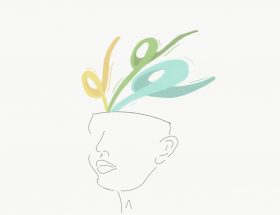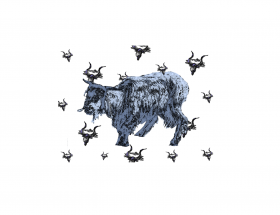If you are a living human on this planet, it is an inevitability that you have a sense of self – regardless of any extraneous factors. The self is an individual perception as the result of the reflection of human consciousness, some might argue that it is indeed our sense of self that defines us as a species, making it is most fundamental element of human life and society. This personal sense of self includes attributes of who we are and what we are to ourselves but also to others.
Research suggests that we can divide our sense of self into three contributing categories: the individual self, concerned with our unique traits as individuals; the relative self, regulating our roles in dyadic relationships; and finally our collective self, responsible for defining those aspects of the self that are based on membership of social groups and categories. All of these separate parts make for one entity that we perceive as our identity – our existence as a human individual. That being said, there are different theories on how these three parts of our “self” are managed within us.
One school of thought claims the dominance of one part over the others, making it the most prominent and offering the lens through which we live our daily lives. Another suggests that the parts actually interact with each other and are equally dominant in guiding us through our environmental experiences and trade each other off depending on the context of our interactions. For the sake of this article, we will explore intergroup conflict and harmony from the angle of the latter of the two theories, assuming an interaction between the three parts of our “self”.
Another typical feature of human life is the formation of social groups. The interaction between different groups has always been of great interest to sociopsychological theories due to their explanatory power when dissecting conflict and harmony within groups but also society in a wider sense. The collective self is based on impersonal bonds to others derived from common identification with a group. Individuals will use their collective selves to categorize themselves within certain social group, making the groups that they belong to the in-group and defining opposing or even just different groups as the outgroup. This division is what lies at the root of intergroup conflict and can be identified in every major societal division throughout history. Hence why conflict theory is an important part of the sociopsychological field.
A ground-breaking theory proposing a framework for resolution of conflict between grousp is Gordon Allport’s contact hypothesis, which suggests that contact between members of different groups can reduce prejudice and intergroup conflict and results in improved social relations. Said improved social relations are characterized and can only exist if the following features are present and supported by contact between the respective parties: equal status, intergroup cooperation, common goals and support by social as well as institutional authorities. The procedure to practically achieve improved social relations and reduced prejudice involves four steps: learning about the out-group, changing behaviour and generating affective ties with members of the group which eventually generate ingroup appraisal for former outgroup members. The use of the contact hypothesis to reduce prejudice between individuals from different social groups has been very successful and has become the cornerstone of many policies within the educational and policy frameworks of modern democracies.
However, the contact hypothesis comes with the downside that it is limited to outlining a procedure for increased contact between two individuals and never actually proposes an alternative procedure where the favourable affiliation would extend to the entire outgroup rather than just the individual the subject is interacting with. Furthermore, it would be near to impossible to practically carry out and create the conditions necessary for successful contact between entire groups and their respective outgroup counterparts, even if there were a procedure in place that could be generalized. However, recent work has shown that structured contact is not always necessary for reduction of prejudice. In fact, even unstructured contact can lead to a strong reduction in prejudice. Thus, Allport’s characteristics are not actually mandatory for reduced prejudice and increased social relations, even though they heavily facilitate these.
This shift in paradigm gave rise to alternative forms of the contact hypothesis that could potentially result in generalization of positive effects to entire outgroups rather than just one individual. The main idea being to adopt a lack of group saliency when interacting with individuals and promoting social relations by generating an overarching common group identity for all the individuals that we interact with. If these are the features needed to generalize positive attribution to outgroups, one could suggest that people might achieve this by making slight alterations to their individual selves and intertwining it with their collective self. Individuals could attempt to approach individuals they encounter on the daily by focusing on their personal attributes rather than their group affiliation. This would allow for positive and cooperative interaction despite the two individuals potentially being in two different groups. Group membership of the collaborative individuals would eventually become salient and previous positive social interaction would pave the path towards generalization of positive attributes.
This concept could be applied to many different scenarios be it cultural, socio-economical or even just on a more interpersonal level such as belonging to two different friend groups. I believe that it is of paramount importance to consider these adaptive changes in our everyday lives, as they could make a big difference in how we interact with each other on both local, national and global issues. Migrant influxes could be used as an appropriate example due to the high degree of conflict and prejudice they generate, that are largely rooted in the idea of basic ingroup and outgroup division. Positive social contact as a result of attitude change has been largely beneficial in improving cooperation and reducing prejudice in migrant crises.
Ultimately, a shift towards kinder and more accepting attitudes within our individual selves can strongly impact our collective self and how we act towards those that we might consider to be part of an outgroup. It is important to remind ourselves from time to time that we are all part of a wider species of humans and that our success is inevitably intertwined. If we thrive, we will only thrive together, be it in regard to climate change, migrant influxes or divisive political situations. It is only once we collaborate together, that we can make a change and the best place to initiate that change is within ourselves.
art by Mafer Martinez




